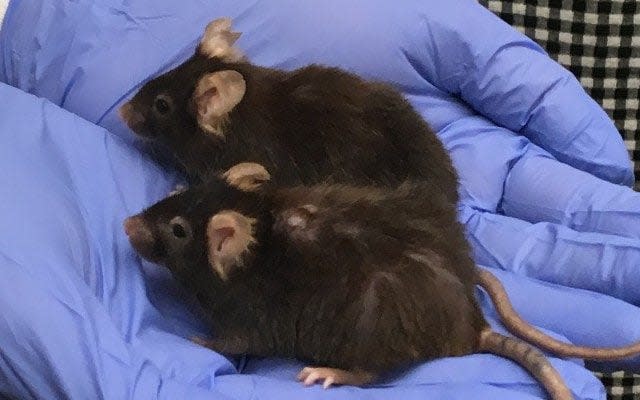The wonder drug that could reverse the ageing process

Sarah Knapton visits the Mayo Clinic to report on how US scientists are trialling senolytics, which target the zombie cells that cause age-related diseases
With its pudgy body, tired eyes and hair loss, the lower mouse could easily be the father of the sprightly and alert animal nestling alongside.
But they are actually the same age, the result of extraordinary trials of drugs which are slowing down or even reversing the ageing process.
Scientists now believe that ageing itself is responsible for many major conditions such as Alzheimer’s, Parkinson’s, arthritis, cancer, heart disease, and diabetes. And they think they have found a way to turn it off.
Anti-ageing drugs - dubbed ‘senolytics’ - are currently being trialled in humans and unlike previous tests which have focussed on a single disease, these drugs work like a broad-spectrum antibiotic, preventing or alleviating most age-related illnesses and frailty.
Scientists at The Mayo Clinic, who first coined the term senolytics, already have six trials in humans under way and plan to start six more shortly. If successful, they estimate that drugs to slow down ageing could be ready within two years.

In mice, the drugs extend lifespan by 36 per cent, the equivalent of adding around 30 years to humans, and crucially the animals remained in good health.
Clinical geriatrician Dr James Kirkland, Director of the Robert and Arlene Kogod Center on Aging at Mayo Clinic, said: “Most people don’t want to live to 130 and feel like they’re 130 but they wouldn’t mind living to 90 or 100 and feel like they’re 60. And now that can actually be achieved in animals.
“Ageing itself is the highest risk factor for most of the chronic diseases. And if you get one age-related disease, you’ve got a huge chance of having several.
“You tend to find older individuals who are completely healthy and are playing 18 rounds of golf a day, or they’ve got three, five or 10 different conditions. There aren’t too many people in between.
“Around 10 years ago we began to explore the notion that ageing may be an upstream cause of all of these conditions and not only be a risk factor but could actually be causal.

“And therefore if you targeted fundamental ageing processes it might be possible to delay, prevent or alleviate these chronic conditions as a group instead of going after them one at a time.
“It’s much more like developing an antibiotic. Antibiotics will treat 25 different conditions, we’re trying to do the same thing.”
The senolytic drugs target senescent cells, also known as ‘zombie cells.’ Senescent cells form from normal cells which have stopped dividing, but instead of dying and being cleared away, they begin pumping out a slew of damaging chemicals which harm healthy cells.
Senescent cells accumulate with age, caused by the stresses of life, and scientists now believe that when they reach a critical threshold, they begin to trigger disease.
Crucially zombie cells have been found around the sites of major disease. They cluster around the lesions which cause heart attacks and strokes, in bones of people with osteoporosis, in the joints of arthritis sufferers, and in the fat tissue of diabetics.

In Alzheimer’s the cells are seen surrounding tell-tale plaques and tangles of protein which prevent brain cells communicating and destroy memories.
Scientists have also shown that if they transplant zombie cells into young animals, they begin to age, and develop age related disease. But importantly, the ageing can be reversed by senolytic drugs.
It was also recently demonstrated that in tissue samples of obese human diabetics, senolytic drugs made fat cells sensitive to insulin again.
“We’re now happy to say that age is causing these diseases,” said Dr Kirkland.
“The important thing medically is you’ve got a mechanism-based treatment which always work a lot better than a symptomatic treatment. If you’re replacing a neurotransmitter in say Parkinson’s it works for a little while but then the disease advances and you get Parkinson’s disease back.”

The drugs are likely to not only affect disease of old age, but also geriatric syndromes such as frailty, mild cognitive impairment and incontinence.
Early human trials are already showing promise. The first published results on a small group of 14 older people with the lung condition idiopathic pulmonary fibrosis found the just nine doses of the drugs over three months, improved walking speed, distance and reduced frailty.
“There has never been any improvement in control groups or trials for this disease, it’s a steady downwards decline,” added Dr Kirkland.
“There was a highly significant and dramatic improvement in their physical function that you just don’t see in this condition, so that gave us enough hope to go on and now we’re doing a much bigger trial.
“We’re starting with people who wouldn’t have that much to lose if something went wrong, because this is a completely new way of treating people.
“But if we find improvements we would want to move to people with less and less serious conditions and maybe even people who have senescent cells but who don’t have the condition yet.”

The drugs used were a combination of dasatinib - usually used to treat leukemia - and quercetin, a flavonoid found in green tea, red wine and apples. Because it takes up to six weeks for cells to become senescent, there is a large treatment window.
Dr Tamara Tchkonia, who works with Dr Kirkland added: “As an optimistic person I can say we might have these drugs in maybe two years.
“We’re at a critical juncture with the trials. There could be a lot of red lights in the tunnel but we have to start doing things differently.”
The research is also having an impact on other fields of medicine. Recently it was discovered that transplanting organs from older people into younger people raised the risk age-related disease, and scientists believe the cause was senescent cells being transferred along with the organs.
Alarmingly, zombie cells in one part of the body can also travel, so senescence in the foot could end up triggering damage in the brain.

The Mayo Clinic has now joined up with seven other research institutions across the US to form the Translational Geroscience Network, which will carry out urgent trials into the drugs.
Dr Kirkland added: “As a clinical geriatrician I got tired of prescribing better walkers wheelchairs and incontinence devices to older people.
“All of my colleagues feel the same way so for many years there has been nothing fundamental and disease modifying that we can do to alleviate frailty.
“But with a single intervention it might be possible now to affect healthspan and lifespan. Indeed that appears to be the case and that makes me hopeful.”

 Yahoo News
Yahoo News 